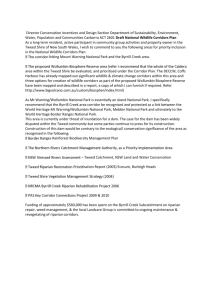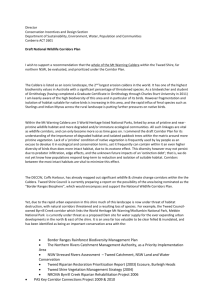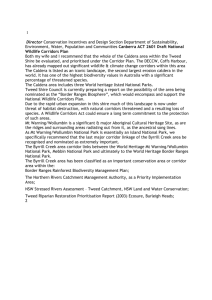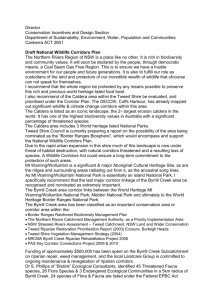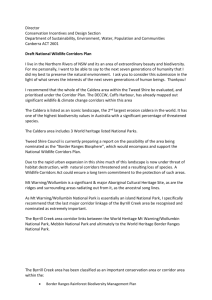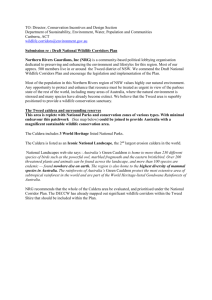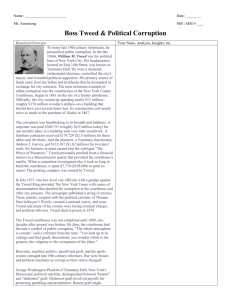Caldera Environment Centre (Word - 775 KB)
advertisement
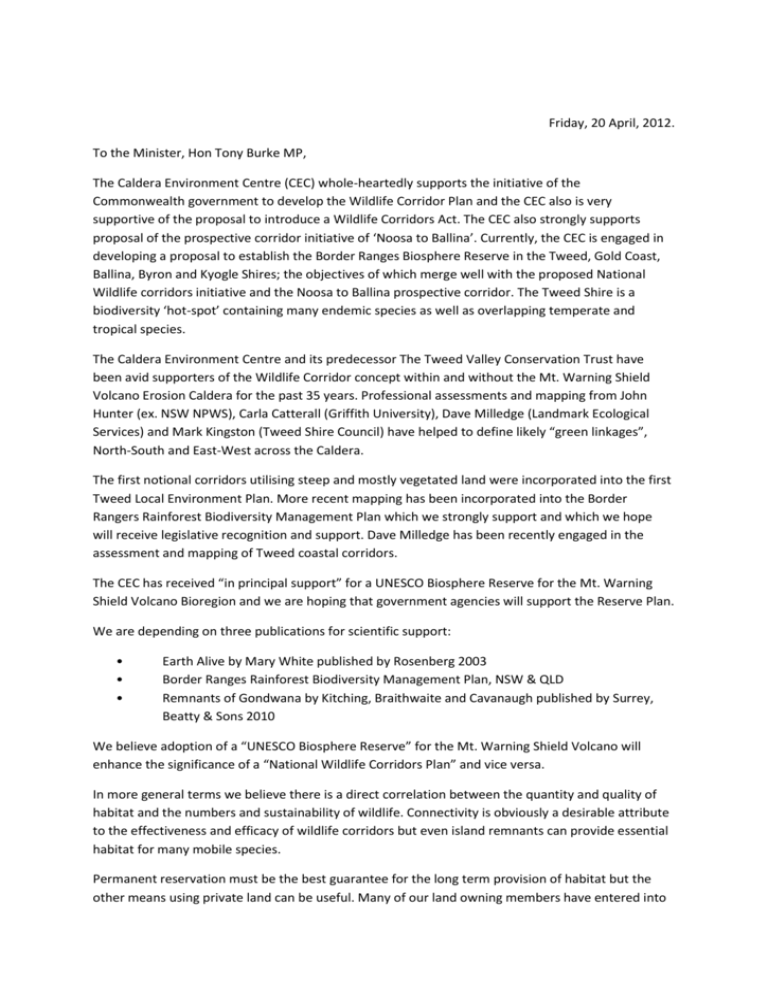
Friday, 20 April, 2012. To the Minister, Hon Tony Burke MP, The Caldera Environment Centre (CEC) whole-heartedly supports the initiative of the Commonwealth government to develop the Wildlife Corridor Plan and the CEC also is very supportive of the proposal to introduce a Wildlife Corridors Act. The CEC also strongly supports proposal of the prospective corridor initiative of ‘Noosa to Ballina’. Currently, the CEC is engaged in developing a proposal to establish the Border Ranges Biosphere Reserve in the Tweed, Gold Coast, Ballina, Byron and Kyogle Shires; the objectives of which merge well with the proposed National Wildlife corridors initiative and the Noosa to Ballina prospective corridor. The Tweed Shire is a biodiversity ‘hot-spot’ containing many endemic species as well as overlapping temperate and tropical species. The Caldera Environment Centre and its predecessor The Tweed Valley Conservation Trust have been avid supporters of the Wildlife Corridor concept within and without the Mt. Warning Shield Volcano Erosion Caldera for the past 35 years. Professional assessments and mapping from John Hunter (ex. NSW NPWS), Carla Catterall (Griffith University), Dave Milledge (Landmark Ecological Services) and Mark Kingston (Tweed Shire Council) have helped to define likely “green linkages”, North-South and East-West across the Caldera. The first notional corridors utilising steep and mostly vegetated land were incorporated into the first Tweed Local Environment Plan. More recent mapping has been incorporated into the Border Rangers Rainforest Biodiversity Management Plan which we strongly support and which we hope will receive legislative recognition and support. Dave Milledge has been recently engaged in the assessment and mapping of Tweed coastal corridors. The CEC has received “in principal support” for a UNESCO Biosphere Reserve for the Mt. Warning Shield Volcano Bioregion and we are hoping that government agencies will support the Reserve Plan. We are depending on three publications for scientific support: • • • Earth Alive by Mary White published by Rosenberg 2003 Border Ranges Rainforest Biodiversity Management Plan, NSW & QLD Remnants of Gondwana by Kitching, Braithwaite and Cavanaugh published by Surrey, Beatty & Sons 2010 We believe adoption of a “UNESCO Biosphere Reserve” for the Mt. Warning Shield Volcano will enhance the significance of a “National Wildlife Corridors Plan” and vice versa. In more general terms we believe there is a direct correlation between the quantity and quality of habitat and the numbers and sustainability of wildlife. Connectivity is obviously a desirable attribute to the effectiveness and efficacy of wildlife corridors but even island remnants can provide essential habitat for many mobile species. Permanent reservation must be the best guarantee for the long term provision of habitat but the other means using private land can be useful. Many of our land owning members have entered into contracts with government and conservation agencies to ensure the long term protection of habitat. “Permanent” habitat reafforestation could be assisted by carbon credit farming schemes. Climate Change has made the need for Wildlife Corridors even more acute and greater provision for the long term wide ranging mobility of native species in terms of latitude, longitude and altitude is increasingly being realised. About the Biosphere Proposal The Border Ranges Biosphere Reserve is an evolving project hosted by the Caldera Environment Centre and supported by the Tweed Shire Council, to develop a local UNESCO Biosphere Reserve centred on the Mt Warning Erosion Caldera. The ultimate boundaries and government composition is yet to be determined however it is hoped that the Border Ranges Biogeographic Region may ultimately be that area of land and water in NE NSW and SE QLD which is comprised of Ballina, Byron Bay, Lismore, Kyogle, Tweed and the Gold Coast Cities and Shires. The broad template follows the UNESCO Man and the Biosphere Programme but the detail will be shaped by a consensual committee process involving local community groups and corporations with the co-operation of the three levels of government within Australia, and the United Nations internationally. What is the Border Ranges Biosphere Reserve? Biosphere Reserve projects were promoted as a conservation/sustainability tool and a major part of the Man and the Biosphere programme arising from the 1992 Rio Earth Conference. In principle support has been given by NSW authorities like the northern Rivers Catchment Management Authority and the North East Regional Office of the National Parks and Wildlife Service. Local Government bodies have also supported the project including; Tweed Shire Council, Byron Shire Council and Ballina Shire Council. Eight years ago the Commonwealth Government Department of Environment and Heritage also gave its support to the project. The Border Ranges Biosphere Reserve project aims to fulfil three functions: 1. A conservation function – contribute to landscape conservation of ecosystems, species and genetic variation 2. A development function – fostering economic and human development which is socioculturally and ecologically sustainable; 3. A logistic function – provide support for research, monitoring and education and information exchange related to local national and global issues of conservation and development. Biosphere Reserves are organised into three interrelated zones: The core area The buffer zone The transition area Only the core area requires legal protection and can correspond to an existing protected area such as a national park or nature reserve. The zonation scheme applied through the biosphere is similar to the outline of management actions provided in the Draft Wildlife Corridors Plan (2012). Also, the management structure is aimed at being open, evolving and adaptive in order for the local community to better respond to external political, economic and social pressures. In this way, the management of the Border Ranges Biosphere project is similar to the management structure proposed in the Draft Wildlife Corridors Plan. Why the Mt. Warning Erosion Caldera? The Mt. Warning Shield Volcano Erosion Caldera is the remnant of a much higher shield volcano that has been heavily eroded by windblown moisture from the South Pacific Ocean. The combination of high rainfall and mineral rich soil has given rise to lush rainforest vegetation with high biodiversity. The junction of the Border Ranges and the McPherson Ranges is called a biodiversity ‘hotspot’ and has been nominated as the geographic centre for the Border Ranges Rainforest Biodiversity Management Plan. UNESCO World Heritage ‘Gondwana’ Rainforests fringe the Mt Warning Caldera. Threats to the natural environment and local ecology While the Border Ranges Biosphere Reserve Project is an exciting development that the CEC hopes to realise in the next few years and happily merges with the priorities and outcomes put forward in the Draft Corridors Plan, there are still many existing threats to biodiversity in the Tweed Shire. Most threats to biodiversity are a result of development pressures, and are directly related to rapidly increasing Tweed Shire population and the development of associated infrastructure (predications for population growth estimate that the Tweed population will grow from ~90 000 (2012) to more than 120 000 by 2030). The problem is not necessarily the population growth but the laissez faire way in which it is being managed by the local council and NSW state governments. What is not being properly considered, particularly by the state government is (i) the development of ecologically sustainable communities or housing, and; (ii) the concurrent provision of employment and industry to provide meaningful, localised work for existing and new residents. While point (ii) is considered highly relevant for the future economic sustainability of the Tweed Shire, it is somewhat beyond the terms of reference of this submission. Of more relevant concern is point (i) which includes the proposed construction of the Cobaki and Kings Forest Development sites and the proposed Byrrill Creek dam that will be necessary to service them. Cobaki and Kings Forest Developments – conflating human and ecological functions: multipurpose wildlife corridors? The proponents of the King’s Forest and Cobaki Lakes developments within the Tweed Shire have gradually ben diminishing the environmental qualities of these sites, even to the extent of infiltrating National Parks Estates and undertaking illegal clearing there (http://www.tweedecho.com.au/index.php?option=com_content&task=view&id=3162&Itemid=538). The currently approved concept plan includes “multi-purpose” wildlife corridors which the developer proponent claims will fulfil the functions of wildlife corridor, green open space, bike paths and site drainage. The CEC does not consider that the proponent is seriously considering the needs of natural ecology and is merely engaged in an exercise of meeting statutory requirements with as minimal expenditure as possible. Koalas The Tweed Coast Koala Habitat Study (2011http://www.tweed.nsw.gov.au/YourEnvironment/KoalaManagement.aspx), describes a bleak future for Koala populations in the Tweed Shire, especially for those inhabiting coastal regions. Without intensive management the Tweed coastal koala population is expected to decline to the point of localised extinction by 2030. The CEC and its members and affiliates have been campaigning for a better outcome for coastal flora and fauna since it was established in 1990, but current development trends tend to rationalise habitat clearing and ignore cumulative impacts from development of urban areas and housing. It is hoped that with the establishment of an initiative such as the National Wildlife Corridors Plan, that populations of local species facing extreme pressures will be able to be more resilient in the future. Also it would be hoped that with the establishment of the National Wildlife Corridors Act that such blithe conflation of human and ecological uses as have been currently proposed in the current Cobaki and Kings Forest concept plans can be avoided The Byrrill Creek Dam The Tweed Shire Council is currently considering future water supply options. One of the preferred options is to construct a dam at Byrrill Creek. The new dam is considered a necessity due to the expected growth in population of the Tweed shire over the next 20 years. The CEC counters this official assertion with the claim that Tweed council has done the bare minimum in providing sustainable water infrastructure to residents and is not properly considering the intent of Ecologically Sustainable Development (we make this claim with some authority; having been a member of the Tweed Council working group into the water supply options). Figure 1: Inundation area of the proposed Byrrill Creek Dam The problem with this proposal is that it will submerge one of the area’s water courses which remains in good condition. The Draft Corridors plan acknowledges the work of individuals and groups in undertaking ecological restoration work over the past 30 years; and at Byrrill Creek such restoration work has been ongoing for the past 10 or more years, an estimated $560 000 has been spent by state and federal agencies in this time. The results have been impressive with a massive reduction in weeds along the immediate riparian corridor and a concomitant increase in native species regeneration. The final and most serious concern of the Byrrill Creek option is the location (see Figure 1, above). The proposed dam is situated between conservation areas and will affect the landscape connectivity between these conservation areas. Similarly because of the local topography, the ecosystems of valleys within the catchment are distinct from hillsides and mountain tops; the creek and river valleys of the Tweed Shire are typically defined by subtropical gallery rainforest (Lowland rainforest on flood plain is listed as an Endangered Ecological Community under the NSW Threatened Species Conservation Act). The construction of a dam will irrevocably destroy the subtropical rainforest areas (which have been assiduously maintained by volunteers such as Byrrill Creek Landcare) and sever vital linkages. Summary The CEC has established itself as the Tweed’s leading conservation group by championing the cause of wildlife corridors since 1990. Our current project to establish a UNESCO biosphere reserve for the Tweed volcanic region is a complimentary aim to the Draft national Wildlife Corridors plan. It is an unfortunate fact that the development of the Tweed Shire for residential purposes is placing massive stresses on the ecology of the region to the point of causing the localised extinction of the Australian icon, the Koala. Also, it is saddening to see the local council proposing infrastructure solutions that will destroy regenerating habitat areas and sever vital landscape linkages. The CEC hopes the recommendations of the Draft Plan become fully manifest and manifold. We endorse the Plan. Sincerely Yours Paul HopE Hopkins, Coordinator Caldera Environment Centre. [Additional Information supplied by Samuel K. Dawson (BAS Hons), Secretary, Caldera Environment Centre.]
